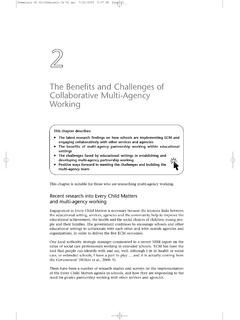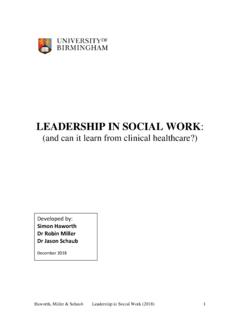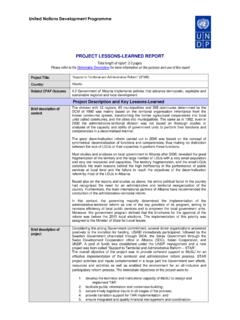Transcription of Working with People who are marginalized by the social ...
1 Working with People who are marginalized by the social system : challenges for community psychological work1. Carolyn Kagan2, Diane Burns3, Mark Burton4, Isabel Crespo5, Rob Evans2, Kath Knowles2, Jos Luis Lalueza5 and Judith Sixsmith2. Correspondence: Carolyn Kagan, Department Psychology and Speech Pathology Manchester Metropolitan University Hathersage Road Manchester M13 0JA, UK. 1. Much of this paper is adapted from an expanded version of this paper, to appear as M. Burton and C. Kagan (in press). Marginalization. in I. Prilleltensky and G. Nelson. Community Psychology: In pursuit of wellness and liberation. London: Macmillan/Palgrave 2. Manchester Metropolitan University, UK. 3. Sheffield Hallam University, UK. 4. Manchester Learning Disability Partnership 5. Universitat Aut noma de Barcelona 1. PDF created with FinePrint pdfFactory trial version Overview Working with People who are marginalized by the social system presents community psychologists with a number of challenges that extend beyond fundamental principles such as prevention, empowerment, and participation.
2 Different contributors to this paper, all of whom have been involved in different ways to the work of the journal Community Work and Family, draw on their direct work with People who are marginalized by the social system to highlight tensions and dilemmas for community psychological work. These include: the negotiation of values and ways of Working ; multi-level Working within a complex system ; issues of measurement and epistemology; intercultural and interdisciplinary Working ; liberal or liberation principles; methods of Working and data collection; and conceptual critiques. What is social Marginalization? Marginalization is a slippery and multi-layered concept. Whole societies can be marginalized at the global level while classes and communities can be marginalized from the dominant social order. Similarly, ethnic groups, families or individuals can be marginalized within localities. To a certain extent, marginalization is a shifting phenomenon, linked to social status.
3 So, for example, individuals or groups might enjoy high social status at one point in time, but as social change takes place, so they lose this status and become marginalized . Similarly, as life cycle stages change, so might People 's marginalized position. At certain stages of the life cycle the risk of marginalization increases or decreases. For example, the marginalized status of children and youth may decrease as they get older;. the marginalized status of adults may increase as they become elders; the marginalized status of single mothers may change as their children grow up, and so on. Even so, there 2. PDF created with FinePrint pdfFactory trial version are different risks within particular social groups at risk of marginalization. Eldering and Knorth (1998), for example, demonstrate that the risks of marginalization of immigrant youth in Europe vary with ethnicity, irrespective of the particular host countries, or of degree of acculturation.
4 Peter Leonard (1984, ) defines social marginality as 'being outside the mainstream of productive activity and/or social reproductive activity'. This includes two groups, firstly a relatively small group of People who are voluntarily marginal to the social order - new age travellers, certain religious sects, commune members, some artists, for instance. Here, however, we are concerned with a second group, those who are involuntarily socially marginal. Leonard (1984, ) characterises these People as remaining outside 'the major arena of capitalist productive and reproductive activity' and as such as experiencing 'involuntary social marginality'. The experience of marginality can arise in a number of ways. For some People , those severely impaired from birth, or those born into particularly marginal groupings ( members of ethnic groups that suffer discrimination - the Roma in Europe, Indigenous People in Australasia and the American continent, African Caribbean People in Britain), this marginality is typically life-long and greatly determines their lived experience.
5 For others, marginality is acquired, by later disablement, or by changes in the social and economic system . As global capitalism extends its reach, bringing more and more People into its system , more communities are dispossessed of lands, livelihoods, or systems of social support (Chomsky, 2000; Petras & Veltmeyer, 2001; Potter, 2000; Pilger, 2002). Marginalization is at the core of exclusion from fulfilling and full social lives at individual, interpersonal and societal levels. People who are marginalized have relatively little control over their lives and the resources available to them; they may become stigmatised and are often at the receiving end of negative public attitudes. Their 3. PDF created with FinePrint pdfFactory trial version opportunities to make social contributions may be limited and they may develop low self- confidence and self esteem. social policies and practices may mean they have relatively limited access to valued social resources such as education and health services, housing, income, leisure activities and work.
6 The impacts of marginalization, in terms of social exclusion, are similar, whatever the origins and processes of marginalization, irrespective of whether these are to be located in social attitudes (such as towards impairment, sexuality, ethnicity and so on) or social circumstance (such as closure of workplaces, absence of affordable housing and so on). Different People will react differently to marginalization depending on the personal and social resources available to them,. Nevertheless, some common social psychological processes can be identified. We pay particular attention to processes that facilitate or prevent collective social action (see Burton & Kagan, 1996). Poverty and Economic Marginality People who are experiencing marginalization are likely to have tenuous involvement in the economy. The sources of their income will vary. Some will be waged and some will depend on state benefits, marginal economic activity such as casual work, or charity (see for example, Sixsmith, 1999).
7 It is not unusual for People to combine, or move between, these various ways of getting money in their struggle for survival. Poverty, dependency, and feelings of shame are everyday aspects of economic dislocation and social marginalization. These experiences affect men and women differently and vary with age. Poverty and economic marginalization have both direct and indirect impacts on People 's health. Box 1: social capital and health in an area of multiple deprivation: The case of older men: Judith Sixsmith, We undertook an interdisciplinary study on the relationship between social capital, health and gender, funded by the Health Development Agency. The project 4. PDF created with FinePrint pdfFactory trial version featured a qualitatively based case study analysis of a socially deprived community in the North West of England, involving interviews with 77 community members. Of these, 39. men took part, including 18 older men (aged between 56 and 79 years old).
8 For these older men, masculinities were often constructed around their health, family and employment status. The deterioration of their health status and loss of partners and employment (through ill health or retirement) necessitated a re-negotiation of more marginalized masculinities within the context of community decline. Crime and drug taking were common features of community life. Consequently, the men felt that they were vulnerable and undervalued members of this community and were reluctant to become involved in community groups and activities. An analysis of this reluctance revealed the significance of the genderisation of community spaces. Community facilities were perceived by the men as feminine domains, places where they were unable to play out their notions of masculinity. Since community participation has been identified as important in the development of social capital these men were effectively socially excluded' from venues which might have afforded opportunities to develop bonding and bridging ties.
9 Ultimately this social exclusion' underpinned a level of disempowerment, based on mistrust of other community residents as well as a feeling of inability to personally defend community space and shape community life. Impaired Support Networks and social Marginalization A further problem is the relative or complete exclusion of marginalized People from social networks. People born into marginality will be, at best, able to access resources through strong social networks (for example a person born with impairments into a rich family). Others will be able to access weaker networks, such as neighbourhood, or church based organisations. But often these sources of support will be weak or overburdened. Until we ask People themselves, and develop better ways of enabling them to participate in decisions about their lives - particularly where human service organisations are 5. PDF created with FinePrint pdfFactory trial version involved - we will not know the impact of marginalization on their support networks, nor indeed how best to help them develop supports.
10 Box 2: Starting The Ball Rolling: Collaborating To Evaluate Community Mental Health Services. Kathleen Knowles The idea of user involvement in mental health services is now common currency in the UK among mental health professionals and policy makers. In practice, however, user involvement has been found to be problematic: it is not clear how to begin and once begun it can be hard to sustain. So the challenge of moving from talking about user involvement to putting it into practice is a difficult one. A questionnaire survey was carried out via a collaboration of community mental health centre user groups and a small multidisciplinary group of mental health professionals in the North West of England. The process of the survey as an exercise in consultation, despite problems and disagreements with the survey and its findings, led to an increase in participation of People with mental health difficulties in the District.











